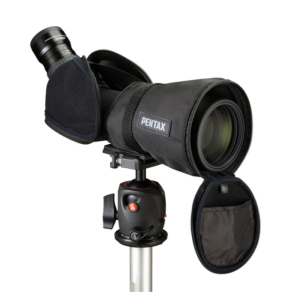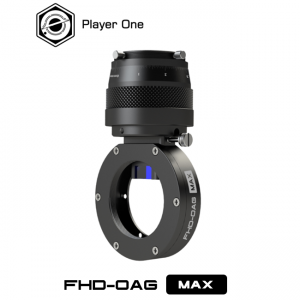The Pentax PF-85EDA 85mm Spotting Scope features a large, crisp lens that ensures vivid and precise visuals, whether you’re observing terrestrial views or gazing at the stars. Its extra-low dispersion glass lenses are treated with several layers of full anti-reflective coatings. The design of the Pentax PF-85EDA reduces aberrations and enhances light throughput, which boosts color accuracy and contrast while also sharpening image clarity and resolution. Although the scope comes without an eyepiece, it is compatible with standard 1.25″ telescope eyepieces.
 The Pentax PF-85EDA’s ED glass optical elements effectively minimize chromatic aberration. It also features a combination of a full multi-coating process applied to all optical elements, and a phase coating process applied to the roof prism to deliver a clear, high-contrast field of view for high-quality observations.
The Pentax PF-85EDA’s ED glass optical elements effectively minimize chromatic aberration. It also features a combination of a full multi-coating process applied to all optical elements, and a phase coating process applied to the roof prism to deliver a clear, high-contrast field of view for high-quality observations.
The interior of the spotting scope is filled with nitrogen gas to prevent fogging caused by sudden temperature changes. This assures a clear field of view even in demanding weather conditions.
Despite its large objective lens, the Pentax PF-85EDA 85mm Spotting Scope is designed to be compact and highly portable, thanks to the incorporation of the latest optical design featuring a roof prism. This compact design makes it easy to be carried to a variety of destinations. Its compact dimensions and portability also come in handy in various types of nature and astronomical observation, including birdwatching.
By inserting a dust-proof glass element in the eyepiece mount, this spotting scope is designed to be airtight for outstanding waterproof performance (equivalent to JIS Class 7, with water resistance to a depth of one meter) for dependable use even in the rain or mist.
The eyepiece section is slanted upward at a 45-degree angle, allowing subject observations over long periods of time in a natural, comfortable posture, without the need to look up. The eyepiece mount features a 1.25-inch sleeve to accept a range of eyepieces, letting you choose the eyepiece that best accommodates a specific application. The built-in lens hood shields out excessive light and protects the objective lens surface. The tripod receptacle with a click-stop rotation mechanism makes for easy twisting of the lens barrel to position the eyepiece at the most comfortable angle.
The Pentax PF-85EDA 85mm Spotting Scope specifications include:
– Design: Slanted-barrel roof-prism spotting scope (45° tilted)
– Lens Construction: 5 elements in 4 groups, ED glass elements with 85mm effective aperture
– Eyepiece Ring Diameter: 1.25 in.
– Focus Range: Approx. 5m to infinity
– Eyepiece Ring: Collet type
– Color: Black
– Dimensions: 13.7 in. (W) x 4.6 in. (H) x 4.0 in. (D)/347 mm (W) x 116.5 mm (H) x 101.8 mm (D)
– Weight: Approx. 56.5 oz/1,600g /
– Waterproof Rating: JIS Class 7
– Included Accessories: Objective lens cap, eye lens cap, case
You can learn more about the Pentax PF-85EDA 85mm Spotting Scope here.

 And to make it easier for you to get the most extensive news, articles and reviews that are only available in the magazine pages of Astronomy Technology Today, we are offering a 1-year magazine subscription for only $6! Or, for an even better deal, we are offering 2 years for only $9. Click here to get these deals which only will be available for a very limited time. You can also check out a free sample issue here.
And to make it easier for you to get the most extensive news, articles and reviews that are only available in the magazine pages of Astronomy Technology Today, we are offering a 1-year magazine subscription for only $6! Or, for an even better deal, we are offering 2 years for only $9. Click here to get these deals which only will be available for a very limited time. You can also check out a free sample issue here.
The Sun is more active than it’s been in years and if that’s not enough, we have the upcoming Total Solar Eclipse on April 8, 2024! If you’d like to learn more about the technology behind solar observing, solar imaging and more, you can check out our new monthly magazine – Solar Astronomy Today. It’s free to read, no subscription needed and available here. And if you are preparing for the upcoming eclipses and want to know your equipment options from solar glasses to the most out of this world solar viewing and imaging options, check out our free publication – The Definitive Guide to Viewing and Imaging the Sun – simply click here and enjoy reading!



